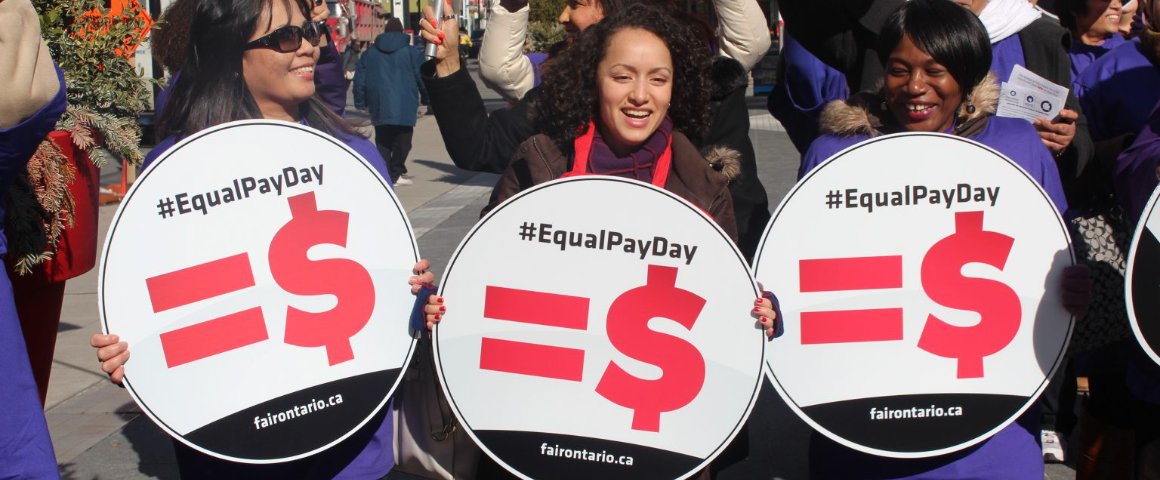By Dave McKee
We are coming up on Equal Pay Day – marked this year on April 16 – which symbolizes how far into the next year the average woman needs to work in order to have made the same amount of money the average man made the previous year.
In other words, a woman needs to work fifteen and a half months to get paid what a man gets in twelve months.
It’s absolutely warped that this is the reality for 10 million working women in Canada.
Unfortunately, the reality is even worse. Equal Pay Day resets each year to start on January 1 of the previous year. But really, if a woman has to work until mid-April of the following year to just make a full year’s income, then Equal Pay Day for the next year would be around the beginning of August. And the year after that, it would land somewhere in mid-December.
So, after just four years, the average woman is already a full year behind the average man in terms of annual income.
In addition to the enormous negative effect this has on women’s quality of life during their working years, it creates compound effects when they head into retirement – through vastly reduced pension benefits and retirements savings, for example.
During the 2019 federal election, this publication calculated the overall gender pay gap in Canada to be in the area of $148 billion each year. This figure is almost incomprehensible. It means that each generation of working women, assuming an average of 45 years of work, loses out on $6.7 trillion – and that doesn’t even consider inflation.
And where does this money go, if not to the working women who (should have) earned it?
Bluntly put, it goes to capital. That’s obvious if the woman works for a private business – the company simply pockets the wage gap and enjoys its higher profit margin. It’s less obvious if the woman works in the public sector, but it kind of works out the same. The public institution pockets the wage gap and doesn’t need to be funded for that amount, which means corporate taxes can be minimized because they’re essentially subsidized and offset by money effectively fleeced from working women.
And to be clear, the pay gap sits at (and preys upon) the intersection of oppressions in our society – it is far wider for Indigenous, racialized, 2S/LGBTIQ+ women and women with disabilities.
Capitalism relies on this kind of institutionalized inequality to function, and capitalist governments deliberately pursue policies which help maintain it. Think about Ontario Premier Doug Ford’s infamous Bill 124, which limited wage and benefit increases in the broader public sector to just one percent. This bill affected so many working women that the overall gender pay gap in Ontario actually increased as a result.
It’s a systemic problem, but one that is exacerbated by policies. So, while we need systemic change to solve it, we can also fight for policies which alleviate it in the meantime.
The Ontario Equal Pay Coalition has launched an online letter campaign which targets provincial politicians and encourages them to pursue policies which improve the gender pay gap – or, at the very least, don’t make it worse.
One of the key policies the coalition has in its sights is privatization of public services.
It’s long been established that strong public services – characterized by democratic control, universality and accessibility – are key to promoting economic equality for women and other equity-deserving groups. Programs like affordable childcare, healthcare, education and support for survivors of domestic violence make a huge difference in shrinking the gender pay gap.
But when those programs are privatized, the profit motive displaces the social purpose. Prices increase, access is reduced, wages and benefits are slashed, and full-time jobs suddenly become part-time or casual. This negatively affects all working people but especially women.
Pay equity is the law, which means that governments – and social systems – which maintain a pay gap are criminal.
[Photo: Ontario Equal Pay Coalition]
Support socialist media!
If you found this article useful, please consider donating to People’s Voice or purchasing a subscription so that you get every issue of Canada’s leading socialist publication delivered to your door or inbox!
For over 100 years, we have been 100% reader-supported, with no corporate or government funding.




